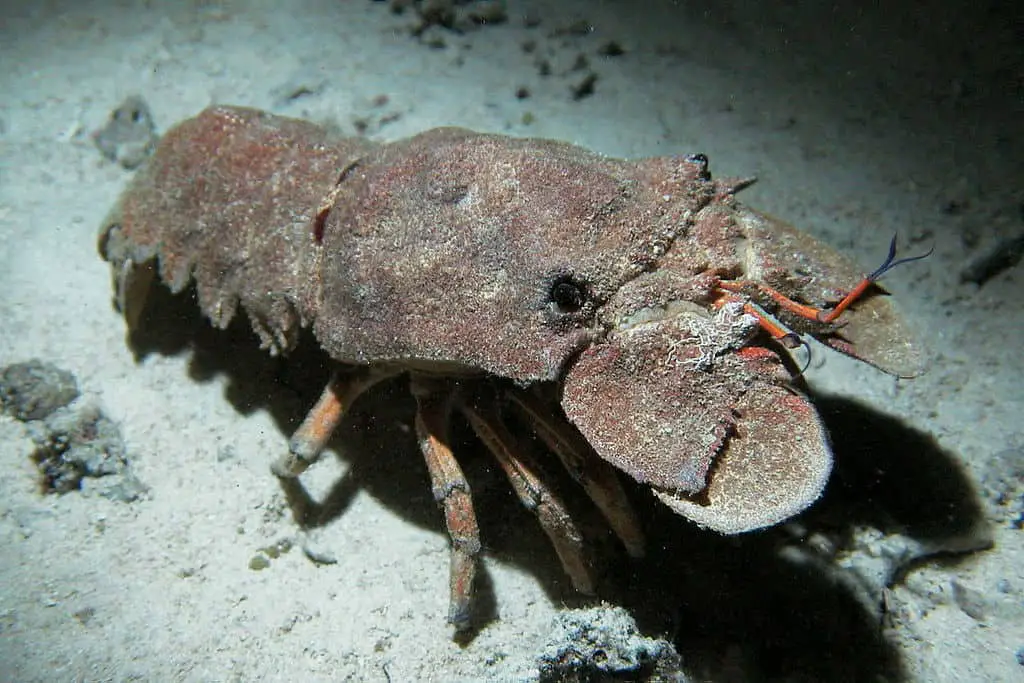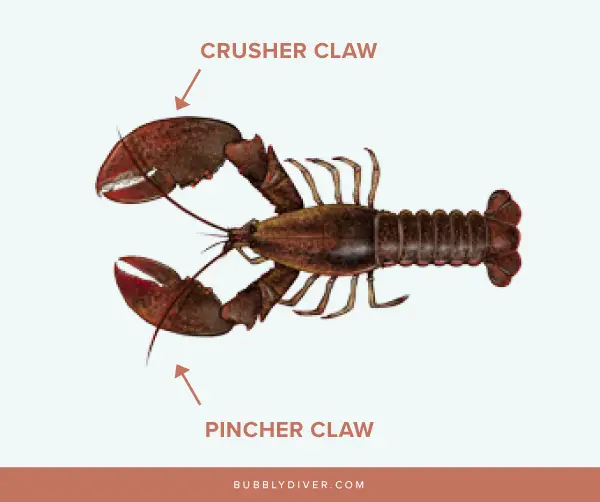Do All Lobsters Have Claws? (Explained)
I always imagined lobsters with big claws, and I think most people imagine lobsters like that too. Then I went scuba diving in the Caribbean for the first time, and I was pretty surprised to see all the lobsters without claws. Therefore, if you wonder if all lobsters have claws, we’ll talk all about it in this blog post. Let’s begin with a quick answer:
Not all lobster species have claws as there are different lobsters’ families: clawed lobster species and non-clawed lobster species, such as spiny, slipper, or furry lobsters. Clawed lobster species live in colder waters, such as American lobster is popular on the Northeast of the US and non-clawed lobster species prefer warmer waters, such as spiny lobster in the Caribbean.
However, this certainly doesn’t tell the whole story. Below I’ll explain more about why some lobsters do have claws and others don’t. Furthermore, I’ll describe clawed and non-clawed species, explain why lobsters have two different claws and why some of the clawed lobsters are missing their limbs. Read on!
Why do some lobsters have claws and others not?
Not all lobsters carry claws because there are different lobster species with different anatomies. There are four major families of lobsters, and actually, only one of them has claws. Lobsters’ main families are:
- the clawed lobster (Nephropidae),
- the spiny lobster, also known as rock lobster (Palinuridae),
- the slipper lobster, also known as Spanish lobster (Scyllaridea),
- the furry, also known as coral lobster (Synaxidae).
These lobsters’ families differ in how their body is built, their habitat, and their behavior. Despite the difference between the first pair of legs – claws, they have a lot of other distinct features. There are differences in the morphological structures on the front of their shell (carapace), the structure of their appendages, the shape of the carapace, the length and shape of their antennae, and more.
In general, all lobsters have paired appendages: first antennae, second antennae, mandibles, first maxillae, and second maxillae. Next, they have five pairs of walking legs (pereiopods). These legs are slightly modified, depending on the lobster’s family. For instance, in clawed lobster species, the first pair of legs is modified into large claws, and that’s why they look different.
Below you can see the table with the biggest differences between lobsters’ claws, other appendages, and more.
| Feature | Clawed lobster | Spiny lobster | Slipper lobster | Furry lobster |
|---|---|---|---|---|
| First pairs of legs | The first 3 pairs clawed, the first one much larger | Not clawed, but females have small grooming claws | Not clawed, but females have small grooming claws | Not clawed |
| Front of carapace | Single rostrum between eyes | Two horns over the eyes | No rostrum and horns | Single rostrum between eyes |
| Antennae | Moderate length | Long | Short, broad, and flattened | Moderate length |
| Eyes | Stalked | Stalked | Sunken in orbits | Sunken in orbits |
| Habitat | Cold water | Tropical waters | Tropical waters | Tropical waters |
Lobsters that do have claws

There are about 38 species of clawed lobsters family, including the most common lobsters, such as American or European lobsters. Other less known species in this family are Norway lobster, Nephropsis rosea, Thymops birsteini, and more.
Clawed lobsters are characterized by a pair of claws in the front and four pairs of appendages. Their second and third pair of legs are actually also claws but much smaller and are used for helping to rip the food apart and walking. The fourth and fifth pair are used for walking only.
Interestingly, lobsters’ claws become bigger and more massive with age. Therefore if you see a lobster with huge claws, it’s probably pretty old. Older lobsters are also more aggressive and don’t get scared easily by their predators. Instead, they show their claws to scare them away.
Some lobsters can live even more than 100 years so their claws can get pretty massive. In general they’re not very dangerous to humans but, of course depending on the size of the claw, could cause you a severe pain. Read more about the power of the claws in my other blog post “Are Lobsters Dangerous?”.
Where do the clawed lobsters live?
Clawed lobsters live on rocky, sandy, or muddy ocean floor and prefer colder waters. This is why you can find them in Atlantic Ocean, especially along the North Atlantic coast of North America. The very popular in this region is an American lobster species, most abundant in coastal waters from Maine through New Jersey.
The European and Norway lobsters are another common species which are found in the eastern Atlantic from northwestern Norway to the Azores (Portugal) and Morocco. Other clawed lobster species might be found off the coast of South America and South Africa.
Lobsters that don’t have claws
We can define three types of lobsters that don’t carry claws: the spiny lobster, the slipper lobster, and the furry lobster. These lobsters mainly prefer warmer waters so can find them while scuba diving or snorkeling in tropical destinations.
The spiny lobster

There are about 60 species of spiny lobsters, such as common Panulirus argus, California spiny lobster, or Panulirus versicolor. Spiny lobsters (or rock lobsters) don’t carry claws. Instead, they have many spines on their carapace and two long antennae on their heads for protection.
These spines are forward-pointed and sharp, so it’s an effective way to protect themselves from predators. If you ever try to hold a spiny lobster, there’s a high chance that you’ll hurt your hands. You can read more about how you can possibly get hurt from a lobster in my other article here.
Another strategy they use to avoid being eaten is to swim away backward by using their flexible tail. As you can see, they don’t necessarily need claws to protect themselves.
Another major difference between these species and clawed lobster species is that spiny lobsters carry horns over their eyes rather than having a rostrum. They have five pairs of appendages that they use for walking and eating.
Interestingly, females of the spiny lobster species do have claws on the fifth pair of legs, called grooming claws. However, they’re tiny and are used to groom the eggs when they are attached to their tail. You can read more about the laying eggs process in my other article: “The Complete Life Cycle Of Lobsters (+ Reproduction)”
Where do the spiny lobsters live?
Spiny lobsters prefer warm waters, so you can mostly encounter them in tropical and subtropical parts of the Atlantic Ocean, the Caribbean Sea, and the Gulf of Mexico. They’re also found in the Mediterranean Sea, coastal waters of Southeast Asia, Australia, and South Africa.
The slipper lobster

There are about 90 slipper lobster species, and some of the most common are Scyllarides latus or Ibacus peronii. These species also don’t carry claws and look incredibly different from other lobsters. They’re also known as Spanish lobsters or shovel-nosed lobsters.
Slipper lobsters have a flattened shell (carapace) and no rostrum or horns over their eyes. They have very short and broad second antennae that resemble large plates that extend horizontally forward from the lobster’s head.
These animals are much more difficult to find due to their camouflage. Unlike colorful spiny or clawed lobsters, their carapace is grey, allowing them to hide from predators. Slipper lobsters don’t rely on their flexible tails to escape danger but on their heavily armored carapace and camouflage.
Where do the slipper lobsters live?
Slipper lobsters inhabit warm parts of the Atlantic and Pacific Oceans. You can find them in the Mediterranean and the Caribbean Sea, Southern Asia, South America, or the coast of Africa, but they’re much rarer than their relatives, such as spiny lobsters.
The furry lobster

Coral lobsters (or furry lobsters) are quite rare, and there are only a few known species at the moment. These animals’ antennae are smaller than in spiny and slipper lobsters, and their body is covered in short hairs.
Where do the furry lobsters live?
From what we know so far, furry lobsters prefer warmer waters, just like all other lobsters without claws. One of the furry lobster species was found in French Polynesian islands: Samoa and Tuamotu. Some scientists say the central pacific ocean could be their ideal habitat. Other furry lobster species were found near Puerto Rico and Brasil.
Why do lobsters have two different claws?
When you look closely at lobsters’ claws, you’ll notice a slight difference in appearance. It’s because lobsters have two different claws that they use for different reasons: the crusher and the pincher claw.

The crusher claw is larger and, as the name suggests, is used for crushing the prey. This claw is more massive and can exert more pressure than the other one. The pincher claw is sharper and used to rip into the prey.
Interestingly, lobsters can be right or left-handed (or clawed), and the position of the pincher claw determines it. Therefore, the lobster is left-handed if the pincher claw is located on the left side of the lobster’s body.
Moreover, lobsters’ claws are identical in the larvae stage, becoming specialized after several months. Most lobsters are right-handed, just like humans.
Why does clawed lobster not have its claws?
It is possible to find a clawed lobster with its claws missing. Sometimes they lose them during lobsters’ territory fights or because they were attacked by predators. Fortunately, lobsters have the ability to fully regrow their lost claws.
Moreover, they also regrow them in order. If a lobster loses a crusher claw, the pincher claw will transform into a crusher with the next molt. Furthermore, the new cutter will grow in the place of the crusher.
The entire process of regenerating lost claws can take about two years or more, depending on the individual and how bad the damage is. Interestingly, lobsters can regrow entirely removed claws but not the ones that are only damaged.
If a claw is not lost, regeneration chances decrease because the body doesn’t perceive the damage. If this scenario happens, lobsters sometimes cut off their own claws if they’re damaged. Other limbs that lobsters can regrow are their antennae and legs.
Sources
- Bunkley-Williams, L., & Williams, Jr., E. (2010). First Record of the Caribbean Furry Lobster, Palinurellus Gundlachi (Decapoda, Synaxidae) in Puerto Rico and as a Food Item of the Red Hind, Epinephelus Guttatus (Perciformes, Serranidae), Crustaceana, 83(7), 893-895. doi: https://doi.org/10.1163/001121610X502957
- Lin, C., Lin, C., & Chan, T. (2012). First record of the rare lobster Palinurellus wieneckii (De Man, 1881) (Decapoda, Achelata, Palinuridae) from Taiwan, Crustaceana, 85(11), 1385-1391. doi: https://doi.org/10.1163/15685403-00003130
- J. Cobb, Bruce Phillips “The Biology and Management of Lobsters.” Academic Press, 1980
You may also like:

Welcome to Bubbly Diver!
I’m glad to see you here. This blog is created for all marine creature lovers by a bubbly diver - me, Dori :)


